Focused shock wave (F-SW) therapy and radial pressure wave (RPW) therapy have been shown to stimulate the body’s natural healing process, with positive effects on bone and tendon repair, as well as tissue regeneration26. But how can these effects be applied practically to treat patients?
COMMON INDICATIONS FOR SHOCK WAVE THERAPY
Tendon pathologies – hamstrings, Achilles tendon, patellar tendon, shoulder ‘rotator cuff’
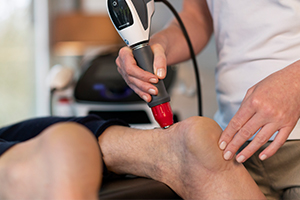
Tendon pathologies – hamstrings, Achilles tendon, patellar tendon, shoulder ‘rotator cuff’
F-SW and RPW While it was a long-held belief that chronic tendons were not capable of repair, studies have shown that F-SW is effective in significantly stimulating the growth indicators associated with tendon, bone, and tendon-bone interface1,2. Positive outcomes have also been recorded with RPW treatment3.
Frozen shoulder
F-SW and RPW Frozen shoulder is an idiopathic and progressive disease, identified by pain and decreased range of motion (ROM) of the shoulder and shoulder joint capsule fibrosis. The use of F-SW seems to have positive effects on treatment, quicker return to daily activities, and quality-of-life improvement on frozen shoulder4. RPW has also been shown to be effective5.
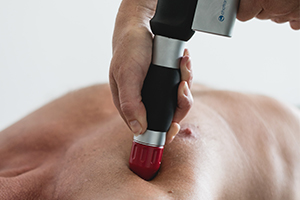
Calcifications F-SW and RPW Both F-SW and RPW can provide positive results in reducing calcification, with improvements recorded in shoulder pain, range of motion, and function, while combining the two has been shown to provide even better results6.
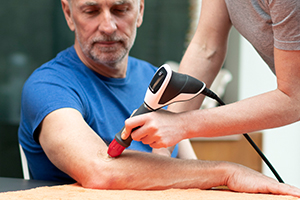
Tennis elbow
F-SW and RPW Tennis elbow, or lateral epicondylitis, is a common source of pain among manual workers. It has been demonstrated that F-SW was more effective than ultrasound therapy for improving pain and grip strength when treating tennis elbow, and also yielded better subjective evaluation7. Additionally, RPW therapy has been shown to yield higher improvements than steroid injections in treating lateral epicondylitis8.
Carpal Tunnel Syndrome F-SW and RPW Positive outcomes have been observed for pain symptoms, functional outcomes, and median nerve activity9.
Chronic neck pain F-SW and RPW F-SW is more effective than ultrasound for improvement of myofascial pain syndrome, and equally effective as dry needling and laser therapy. It is also less invasive and less prone to adverse effects or allergic reactions than those conventional therapies10. Trigger point treatment with RPW used in combination with physical therapy has also been shown to relieve neck and shoulder pains11. However, it is important to mention that the anterior cervical area is contraindicated for localized shock wave therapy, and that only experienced clinicians should consider such treatments, as care must be taken to avoid neurovascular bundles.
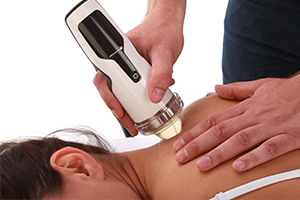
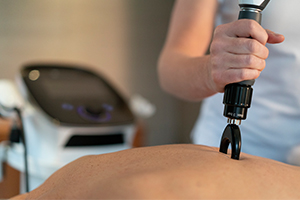
Low back pain
F-SW and RPW Studies have shown that RPW added to conventional physiotherapy and core stability exercises has a significant effect on the reduction of chronic low back pain and the improvement of functional condition compared to a conventional physiotherapy program12. F-SW has also proven effective13.
Muscle hypertonia F-SW and RPW It has been demonstrated that both F-SW and RPW are effective in reducing muscle spasticity and improving motor recovery after stroke14, while RPW has also shown positive results in reducing pain and muscle tone in multiple sclerosis patients as part of a rehabilitation program15.
Hip pain
F-SW and RPW While low-energy shock wave interventions cannot be used to treat hip conditions such as avascular necrosis or intracapsular pathology, RPW has been shown to be effective in treating greater trochanter hip pain16,17. F-SW appears to be effective for aiding in pain relief and functional recovery in patients with osteonecrosis of the hip18.
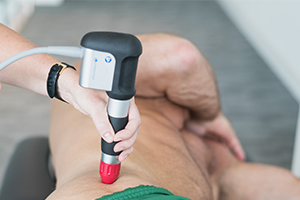
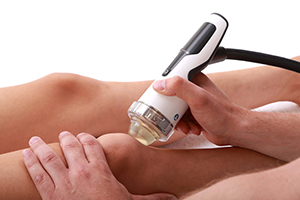
Knee osteoarthritis
F-SW F-SW has been proven effective for improving pain and function in knee OA, with medium energy values having significantly greater effect than low energy19,20.
Shin pain (‘splints’) F-SW and RPW Traditional treatment of medial tibial stress syndrome (MTSS) is generally lengthy, associated with frequent recurrences, and in some cases, an unacceptable degree of improvement. In one study, a single application of F-SW treatment in combination with a specific exercise programme accelerated clinical and functional recovery from MTSS21. Adding RPW to standard home exercise therapy has been shown to offer significantly more improvement of pain, degree of recovery, and return to sports22.
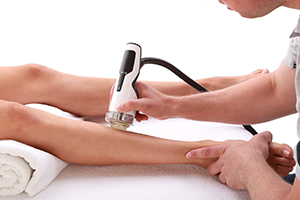
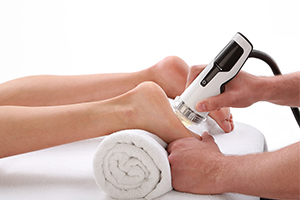
Plantar fasciitis
F-SW and RPW F-SW has been shown effective in reducing heel pain associated with chronic plantar fasciitis23. RPW therapy has been demonstrated to improve pain, function, and quality of life in patients with recalcitrant plantar fasciitis24.
Erectile dysfunction F-SW The number of studies of low-intensity focused shock wave therapy for erectile dysfunction (ED) have increased dramatically in recent years, with results indicating F-SW significantly improves ED and the efficacy can last up to 3 months and more. Furthermore, it may have the potential to be the first-choice non-invasive treatment for patients with ED25.
Wound healing F-SW It has been well established that, through the principle of ‘mechanotransduction’ (the process by which a mechanical stimulus is converted into a set of biochemical reactions and a cellular response), F-SW can positively influence the chain of biological reactions that lead to tissue regeneration and healing26.
Diabetic foot F-SW As with wound healing in general, F-SW as an adjunct to standard wound care has been shown to significantly reduce the size and the healing time for wounds associated with chronic diabetic foot ulcers27.
Cellulite RPW RPW therapy is well established in the aesthetics market, having been shown to be an effective treatment for improving the appearance of cellulite, with significant improvement recorded in skin firmness and structure28.
REFERENCES
- Notarnicola A, Moretti B. The biological effects of extracorporeal shock wave therapy (eswt) on tendon tissue. Muscles Ligaments Tendons J. 2012 Jun 17;2(1):33-7.
- Waugh CM, Morrissey D, Jones E, Riley GP, Langberg H, Screen HR. In vivo biological response to extracorporeal shockwave therapy in human tendinopathy. Eur Cell Mater. 2015 May 15;29:268-80; discussion 280.
- Rompe JD, Maffulli N. Repetitive shock wave therapy for lateral elbow tendinopathy (tennis elbow): a systematic and qualitative analysis. Br Med Bull. 2007;83:355-78.
- Vahdatpour B, Taheri P, Zade AZ, Moradian S. Efficacy of extracorporeal shockwave therapy in frozen shoulder. Int J Prev Med. 2014 Jul;5(7):875-81.
- Hussein AZ, Donatelli RA. () The efficacy of radial extracorporeal shockwave therapy in shoulder adhesive capsulitis: a prospective, randomised, double-blind, placebo-controlled, clinical study. European Journal of Physiotherapy. 2016; 18:1, 63-76,
- Abo Al-Khair MA, El Khouly RM, Khodair SA, Al Sattar Elsergany MA, Hussein MI, Eldin Mowafy ME. Focused, radial and combined shock wave therapy in treatment of calcific shoulder tendinopathy. Phys Sportsmed. 2020 Dec 6:1-8.
- Yan C, Xiong Y, Chen L, Endo Y, Hu L, Liu M, Liu J, Xue H, Abududilibaier A, Mi B, Liu G. A comparative study of the efficacy of ultrasonics and extracorporeal shock wave in the treatment of tennis elbow: a meta-analysis of randomized controlled trials. J Orthop Surg Res. 2019 Aug 6;14(1):248.
- Beyazal MS et al. (Turkey). Comparison of the effectiveness of local corticosteroid injection and extracorporeal shock wave therapy in patients with lateral epicondylitis. J Phys Ther Sci. 2015 Dec;27(12):3755-8.
- Kim JC, Jung SH, Lee SU, Lee SY. Effect of extracorporeal shockwave therapy on carpal tunnel syndrome: A systematic review and meta-analysis of randomized controlled trials. Medicine (Baltimore). 2019 Aug;98(33):e16870.
- Zhang Q, Fu C, Huang L, Xiong F, Peng L, Liang Z, Chen L, He C, Wei Q. Efficacy of Extracorporeal Shockwave Therapy on Pain and Function in Myofascial Pain Syndrome of the Trapezius: A Systematic Review and Meta-Analysis. Arch Phys Med Rehabil. 2020 Aug;101(8):1437-1446.
- Damian M, Zalpour C. Trigger point treatment with radial shock waves in musicians with nonspecific shoulder-neck pain: data from a special physio outpatient clinic for musicians. Med Probl Perform Art. 2011 Dec;26(4):211-7.
- Walewicz K, Taradaj J, Dobrzyński M, Sopel M, Kowal M, Ptaszkowski K, Dymarek R. Effect of Radial Extracorporeal Shock Wave Therapy on Pain Intensity, Functional Efficiency, and Postural Control Parameters in Patients with Chronic Low Back Pain: A Randomized Clinical Trial. J Clin Med. 2020 Feb 19;9(2):568.
- Hong JO, Park JS, Jeon DG, Yoon WH, Park JH. Extracorporeal Shock Wave Therapy Versus Trigger Point Injection in the Treatment of Myofascial Pain Syndrome in the Quadratus Lumborum. Ann Rehabil Med. 2017 Aug;41(4):582-588.
- Dymarek R, Ptaszkowski K, Ptaszkowska L, Kowal M, Sopel M, Taradaj J, Rosińczuk J. Shock Waves as a Treatment Modality for Spasticity Reduction and Recovery Improvement in Post-Stroke Adults – Current Evidence and Qualitative Systematic Review. Clin Interv Aging. 2020 Jan 6;15:9-28.
- Marinelli L, Mori L, Solaro C, Uccelli A, Pelosin E, Currà A, Molfetta L, Abbruzzese G, Trompetto C. Effect of radial shock wave therapy on pain and muscle hypertonia: a double-blind study in patients with multiple sclerosis. Mult Scler. 2015 Apr;21(5):622-9.
- Rompe JD, Segal NA, Cacchio A, Furia JP, Morral A, Maffulli N. Home training, local corticosteroid injection, or radial shock wave therapy for greater trochanter pain syndrome. Am J Sports Med. 2009 Oct;37(10):1981-90.
- Furia JP, Rompe JD, Maffulli N. Low-energy extracorporeal shock wave therapy as a treatment for greater trochanteric pain syndrome. Am J Sports Med. 2009 Sep;37(9):1806-13.
- Zhao W, Gao Y, Zhang S, Liu Z, He L, Zhang D, Li W, Meng Q. Extracorporeal shock wave therapy for bone marrow edema syndrome in patients with osteonecrosis of the femoral head: a retrospective cohort study. J Orthop Surg Res. 2021 Jan 7;16(1):21.
- Lee JK, Lee BY, Shin WY, An MJ, Jung KI, Yoon SR. Effect of Extracorporeal Shockwave Therapy Versus Intra-articular Injections of Hyaluronic Acid for the Treatment of Knee Osteoarthritis. Ann Rehabil Med. 2017 Oct;41(5):828-835.
- Kim JH, Kim JY, Choi CM, Lee JK, Kee HS, Jung KI, Yoon SR. The Dose-Related Effects of Extracorporeal Shock Wave Therapy for Knee Osteoarthritis. Ann Rehabil Med. 2015 Aug;39(4):616-23.
- Gomez Garcia S, Ramon Rona S, Gomez Tinoco MC, Benet Rodriguez M, Chaustre Ruiz DM, Cardenas Letrado FP, Lopez-Illescas Ruiz Á, Alarcon Garcia JM. Shockwave treatment for medial tibial stress syndrome in military cadets: A single-blind randomized controlled trial. Int J Surg. 2017 Oct;46:102-109.
- Rompe JD, Cacchio A, Furia JP, Maffulli N. Low-energy extracorporeal shock wave therapy as a treatment for medial tibial stress syndrome. Am J Sports Med. 2010 Jan;38(1):125-32.
- Gollwitzer H et al. (Technische Universität München, Munich, Germany). Clinically relevant effectiveness of focused extracorporeal shock wave therapy in the treatment of chronic plantar fasciitis: a randomized, controlled multicenter study. J Bone Joint Surg Am. 2015 May 6;97(9):701-8.
- Gerdesmeyer L, Frey C, Vester J, Maier M, Weil L Jr, Weil L Sr, Russlies M, Stienstra J, Scurran B, Fedder K, Diehl P, Lohrer H, Henne M, Gollwitzer H. Radial extracorporeal shock wave therapy is safe and effective in the treatment of chronic recalcitrant plantar fasciitis: results of a confirmatory randomized placebo-controlled multicenter study. Am J Sports Med. 2008 Nov;36(11):2100-9.
- Lu Z, Lin G, Reed-Maldonado A, Wang C, Lee YC, Lue TF. Low-intensity Extracorporeal Shock Wave Treatment Improves Erectile Function: A Systematic Review and Meta-analysis. Eur Urol. 2017 Feb;71(2):223-233.
- d’Agostino MC, Craig K, Tibalt E, Respizzi S. Shock wave as biological therapeutic tool: From mechanical stimulation to recovery and healing, through mechanotransduction. Int J Surg. 2015 Dec;24(Pt B):147-53.
- Omar MT, Alghadir A, Al-Wahhabi KK, Al-Askar AB. Efficacy of shock wave therapy on chronic diabetic foot ulcer: a single-blinded randomized controlled clinical trial. Diabetes Res Clin Pract. 2014 Dec;106(3):548-54.
- Russe-Wilflingseder K, Russe E, Vester JC, Haller G, Novak P, Krotz A. Placebo controlled, prospectively randomized, double-blinded study for the investigation of the effectiveness and safety of the acoustic wave therapy (AWT(®)) for cellulite treatment. J Cosmet Laser Ther. 2013 Jun;15(3):155-62.









